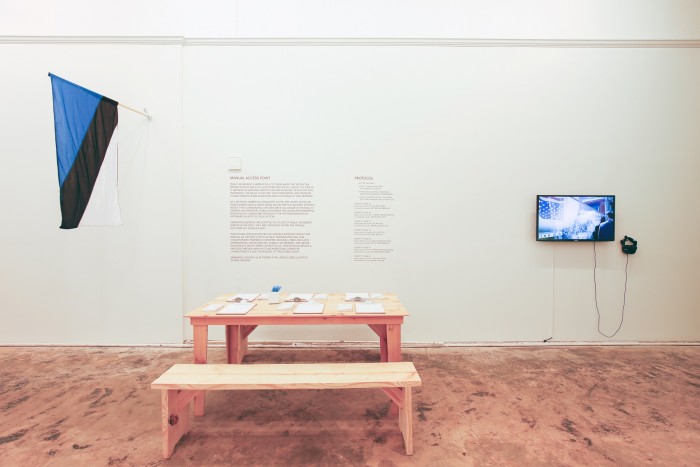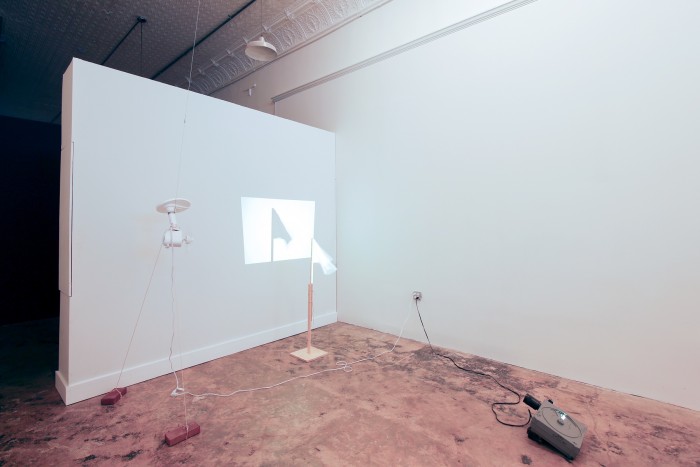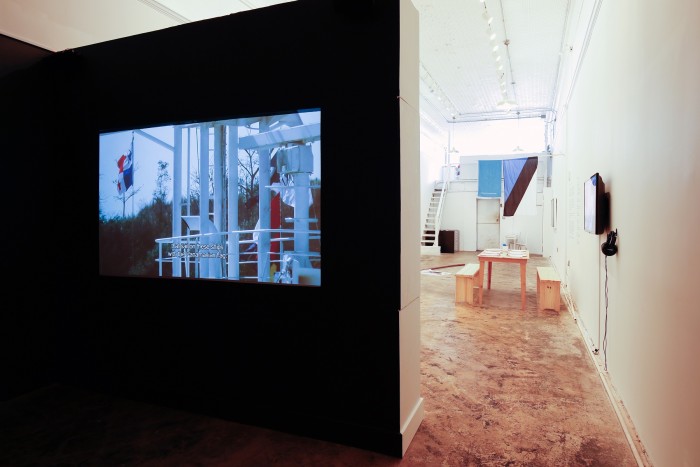Reading time: 5 minutes

02.06.2016
Pelican Bomb, New Orleans, USA
April 1, 2016 – May 29, 2016



Artists: William Binnie, Ariel Reichman, Rona Yefman, Nicolás Guagnini, Exterritory Project, Tania Bruguera, Minerva Cuevas, Public Movement and Jamal Cyrus
In his 1983 book, Imagined Communities: Reflections on the Origin and Spread of Nationalism, political scientist Benedict Anderson famously called a nation an “imagined community,” a group of people who most probably will never meet but imagine themselves as a part of one collective. According to Anderson, this community is brought together through a shared value system, or what he calls, “a deep horizontal comradeship.” In a sense, this bond is codified through the laws of that nation, which protect the rights of its citizens. The definition of a nation in terms of its laws emphasizes the ways that citizens govern themselves. Beyond the binding principles of a shared ideology, the law governs our actions and our property. This aspect of an imagined community is what Michael Billig calls, in his book of the same name, “banal nationalism.” As opposed to its more ardent companion “patriotism,” banal nationalism is “not a flag which is being consciously waved with fervent passion; it is the flag hanging unnoticed in the public building.” In this sense, nationalism is something that is found through unconscious habits and everyday actions rather than the dramatic pageantry found on the battlefield, at state ceremonies, or during international gatherings like the Olympic Games.
But beyond the ways that nations are defined in terms of their internal working, nations are also described in terms of territorial sovereignty. A nation’s space is circumscribed by borders, which we encounter by either looking at a map or by crossing from one nation to another at an airport or checkpoint. This notion of a nation is what Donald Trump invokes when he talks about building a wall between the United States and Mexico. But this idea of a nation with defined physical borders also implies a specific image of the internal makeup of the nation as a community. The physical border is also an ideological border, a division between us and them. In this sense, borders signify not only territory but also identity.
The topic of nation states has garnered a great deal of discussion over the last twenty years as it has become clear that we live in an increasingly globalized world. In terms of economies, the World Trade Organization, the International Monetary Fund, and the World Bank signal a world in which transnational corporations and multinational trade deals unsettle the idea that nations are autonomous socio-economic entities. In the contemporary neoliberal paradigm of capital fluidity, national borders have become blurred. Today, American companies might have factories in Mexico, call centers in India, supply chains that originate in China, and headquarters in the Cayman Islands. For some, a globalized condition is a good thing. It’s about engagement, partnership, and coming together. But for others, the slippage between nation states signals the growth of capitalist forces and their transcendence over concerns about human rights, labor practices, or the environment. For example, these are the concerns that led to the Zapatista movement, which emerged in 1994 in protest against the North American Free Trade Agreement, and the 1999 protests in Seattle against the WTO.
In addition to the challenges posed to the nation state as a singular autonomous community with fixed borders by neoliberal capitalism, nation states are also troubled by immigration and refugees. Today Syrian refugees make up huge proportions of the inhabitants of Lebanon, Jordan, and Turkey and thousands have traveled by boat and by land to find safe haven in Western Europe and elsewhere. The wide range of reactions to this include both compassionate gestures and xenophobia. President Obama said that the U.S. would accept 10,000 Syrian refugees, prompting the protest of a number of politicians including former Louisiana governor Bobby Jindal who issued an executive order banning resettlement of Syrian refugees in Louisiana. Jindal cited the potential danger of these “others” and his duty to protect his citizens.
The hysteria about refugees that provoked Jindal to intervene in federal law was predicated not only on states’ rights but also on an imagined threat that Arabs or Muslims might pose, a view that is consistent with the dominant narrative of conservatives in the U.S. and Western Europe. This is just one in a series of instances that give New Orleans a particular resonance with the ideas behind “False Flags.” Another history that engages the internal debates within the imagined community of the southern United States is the history of the Confederacy, whose traces include monuments, street names, and the highly contentious “rebel flag.”
The notion of a nation as an imagined community relates to artistic practice, which involves imagination to create a believable reality that echoes our own. The artists in False Flags interrogate the systems through which communities signal to one another. They replicate and mutate these signals to create alternative patterns. These signals, which can include literal flags, are the forms through which we imagine both ourselves and others. They are the forms through which we reinforce nationalism or subvert it. Flags are the discursive spaces through which we declare our belonging or our separateness. My hope for this exhibition, which includes a range of dialogical practices, is that it opens up the discourse around both the communities that we live in and the ones that we aspire to.
In conjunction with False Flags, Pelican Bomb has commissioned a collection of essays, interviews, and artist projects for their Art Review that will extend the conversation beyond the gallery’s walls and the artworks included in the exhibition. In the upcoming weeks, artists and writers will explore nationalism, borders, and the visualization of imagined communities. A few of these contributions will look at the ways artists continue to respond to the Confederate flag; examine the nationalistic tendencies of the international biennial circuit; and question the continued use of European languages in postcolonial Africa. These points of view serve as both additional access points to the exhibition and further reading, helping us better contextualize New Orleans’ own discussions surrounding contested lands and cultural identity within global conversations.
Text by Noah Simblist
Courtesy of Pelican Bomb
Comments
There are no coments available.